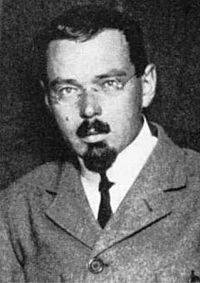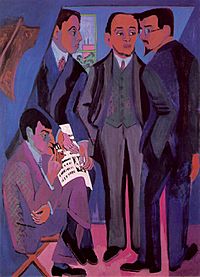Karl Schmidt-Rottluff facts for kids
Quick facts for kids
Karl Schmidt-Rottluff
|
|
|---|---|

Karl Schmidt-Rottluff
|
|
| Born | 1 December 1884 Rottluff (now a district of Chemnitz), German Empire
|
| Died | 10 August 1976 (aged 91) |
| Education | Sächsische Technische Hochschule |
| Known for | Painting, printmaking, woodcutting |
| Style | Expressionism |
| Movement | Die Brücke |
Karl Schmidt-Rottluff (born Karl Schmidt) was a German Expressionist painter and printmaker. He was born on December 1, 1884, and died on August 10, 1976. He was one of the four artists who started the famous group called Die Brücke.
Contents
Early Life and the Die Brücke Group
Karl Schmidt-Rottluff was born in Rottluff, which is now part of Chemnitz, Germany. He went to a secondary school in Chemnitz where he became good friends with Erich Heckel.
In 1905, he started studying architecture at a technical university in Dresden. He soon met Ernst Ludwig Kirchner and Fritz Bleyl there. These four friends shared a strong passion for art.
On June 7, 1905, they decided to form an art group called Die Brücke (which means "The Bridge"). Their goal was to create a new, bold art style that broke away from old traditions. Their first art show was held in Leipzig later that year.
In 1906, Karl added "Rottluff" from his hometown to his name. That summer, he spent time on Alsen with another artist, Emil Nolde. Schmidt-Rottluff convinced Nolde to join Die Brücke.
Schmidt-Rottluff was known as a bit of a loner in the group. From 1907 to 1912, he often spent his summers painting by the coast in Dangast, near Bremen.
Developing His Art Style
From 1905 to 1911, while the group was in Dresden, Schmidt-Rottluff and his friends developed their art together. They were inspired by styles like Art Nouveau and Neo-impressionism.
Schmidt-Rottluff's paintings were special because they had a good balance and simple shapes. This made his art look very flat and striking. In 1910, he painted many famous landscapes that brought him recognition. In December 1911, he and the other Die Brücke members moved to Berlin.
The Die Brücke group broke up in 1913. This happened partly because the artists started moving to Berlin on their own. Also, each artist began to develop their own unique style.
Schmidt-Rottluff started using softer colors in his art. He also focused more on drawing, using dark, strong lines between shapes. This was different from just using contrasting colors, which was common before. Around 1909, he helped bring back the woodcut as an important art form. From 1912 to 1920, his woodcuts became more angular, and he even tried carving wood sculptures.
Later Life and Challenges
Schmidt-Rottluff served as a soldier in World War I from 1915 to 1918. However, his war experiences did not show up much in his artwork. After the war, he joined an artist group in Berlin called the Arbeitsrat für Kunst. This group was against traditional art and supported socialist ideas during the German Revolution of 1918–19.
In the early 1920s, Schmidt-Rottluff's angular style became more colorful and free. By the mid-1920s, his shapes became flatter with softer outlines. Throughout these changes, he always loved painting landscapes.
After World War I, Expressionism became very popular in Germany. Schmidt-Rottluff received many awards and honors. But when the Nazi Party came to power, he lost everything. In 1933, he was kicked out of the Prussian Academy of Arts, even though he had only joined two years before.
In 1937, the Nazis took 608 of his paintings from museums. They even showed some of them in special exhibitions to call them "degenerate art" (art they thought was bad). By 1941, he was banned from painting and expelled from the painters' guild. Many of his artworks were lost when his Berlin studio was destroyed during World War II. After the war, he briefly returned to Rottluff to recover.
Slowly, his reputation was rebuilt after the war. In 1947, Schmidt-Rottluff became a professor at the University of Arts in Berlin-Charlottenburg. He had a big impact on a new generation of German artists there.
In 1964, he made a donation that helped create the Brücke Museum in West Berlin. This museum opened in 1967 and holds many works by the Die Brücke artists. Schmidt-Rottluff was a very productive artist. He created 300 woodcuts, 105 lithographs, 70 etchings, and 78 commercial prints.
He passed away in Berlin on August 10, 1976.
Art in Museums
Karl Schmidt-Rottluff's artworks are displayed in many famous museums around the world. Some of these include the Museum of Modern Art, the Neue Galerie, the Los Angeles County Museum of Art, and the British Museum. The Museum am Theaterplatz in Chemnitz has a very large collection of his work.
In 2011, the Neue Nationalgalerie returned two of Schmidt-Rottluff's paintings to the family of Robert Graetz. These paintings were a self-portrait from 1920 and a landscape from 1910 called Farm in Dangast. Robert Graetz was a businessman from Berlin who was sent away by the Nazis in 1942. A German government group decided that the Nazis had taken these paintings unfairly, so they should be given back.
Schmidt-Rottluff's well-known Self Portrait with Monocle is now in the Staatliche Museum.
Gallery of Works
-
Schmidt-Rottluff, Seehofsallee in Sierksdorf, date unknown; from a poster in Chemnitz
-
Kirchner, Artist Community, (1926/27) oil on canvas; painted after the Die Brücke years. (Schmidt-Rottluff is on the right, with glasses.)
See also
 In Spanish: Karl Schmidt-Rottluff para niños
In Spanish: Karl Schmidt-Rottluff para niños
- Letter from Adolf Ziegler about the Nazi seizure of work
- Departure from the Akademie der Künste




